Please submit comments to sustainability@cityofsitka.org | For questions or assistance, please email or call (907) 747-1856 What is a Greenhouse Gas Emissions Inventory? A greenhouse gas (GHG) inventory measures the amount of heat-trapping gases released by human sources within a defined boundary over the course of a year. Common sources in community-wide inventories include transportation, residential and commercial energy, wastewater treatment, and municipal solid waste. Greenhouse gas inventories can measure the amount of emissions released by the operations of a business, industrial company, faith organization, nonprofit, or a local, state, or national government. Inventories can also be completed at the community scale, covering the emissions released by all human activities that occur within the boundaries of a city, town, or county.  Common categories of emissions includes transportation, home and businesses, electricity generation, solid waste and waste water disposal, and land uses. Why Does Sitka Need a Greenhouse Gas Emissions Inventory? GHG inventories serve as an energy baseline that will play an essential role in the energy planning process. GHG inventories can be used to identify reduction targets and effective strategies for reducing emissions and track increases and decreases in future emissions. They help communities see a comprehensive snapshot of local emissions, energy needs, and other information that can help local government leaders and individuals prioritize actions and make informed decisions about their energy use. | |
| How do you Inventory Greenhouse Gas Emissions? To conduct a GHG inventory, data on energy use in the residential, commercial, and industrial sectors, solid waste, water use and treatment, and transportation occurring within the defined boundary must be collected. Local governments work with a variety of local partners, including local energy utilities, regional transit authorities, and local businesses to collect data and use estimates for data that are unavailable. How do you Inventory Emissions in a Place Like Sitka? Its not easy! Sitka is a unique place with a different lifestyle and emissions profile that don't have widely used data collection methods. To help, CBS is working with experts at the Pacific Northwest National Labs (PNNL) to conduct a community-wide GHG inventory that suits the unique needs of Sitka while still being accurate and informative. | 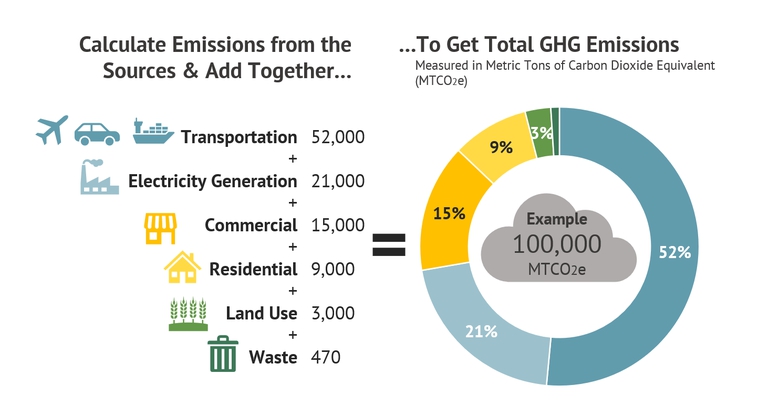 An example GHG emissions inventory. An example GHG emissions inventory. |
With a GHG Emissions Inventory, Goals Can be Set and Accomplished Strategically | |
 | Example Target Goal: A community wants to reduce overall GHG emissions by 50% by 2050. |
The community can either cut emissions by 50% equally... | ...or they can strategically target categories that are important to the community, have available technology, or are easy to reduce. |
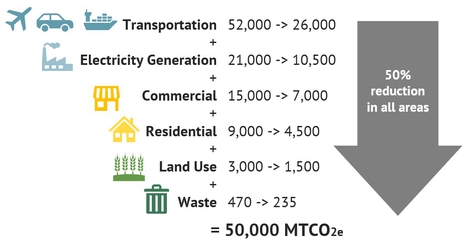 | 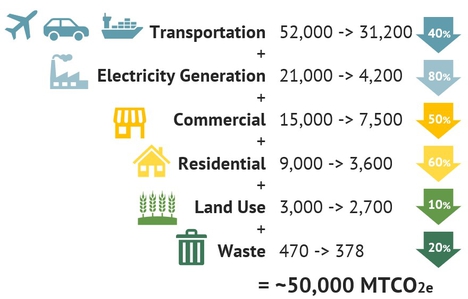 |
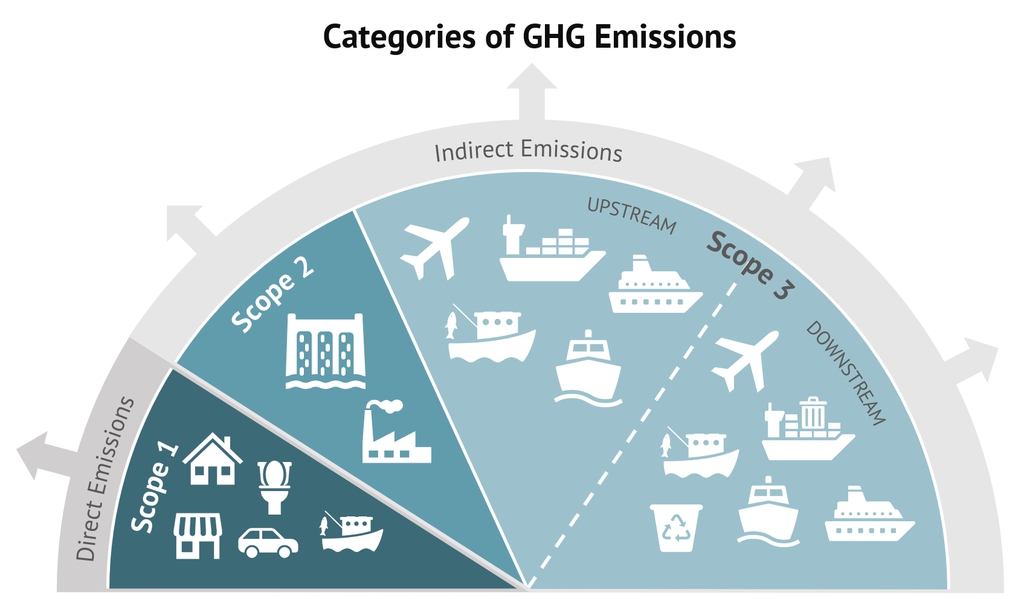 Emissions are categorized into scopes 1, 2 and 3, depending on whether they are emitted directly or indirectly. Emissions are categorized into scopes 1, 2 and 3, depending on whether they are emitted directly or indirectly. | ||||
Scope 1 - Burn Also known as direct emissions, scope 1 emissions include all GHG emissions from the heating and cooling of residential and non-residential buildings, transport of people and freight occurring within city's boundaries. A shorthand for scope 1 emissions is “burn” because it includes things your community burns—fuel to heat or power buildings, vehicles, and other equipment. Scope 1 also includes accidental or fugitive emissions like chemical and refrigerant leaks and spills. Scope 1 emissions can be broken down into the following categories:Stationary combustion: Fuel, like oil and gas, burned in buildings or equipment in the community. Think boilers and other fuel-powered machinery used for industrial processes. Mobile combustion sources: Fuel used for vehicles and mobile equipment like cars, trucks, and other gas-powered tools. Fugitive emissions: Refrigeration chemicals released from AC and equipment and fire suppression chemical released from or used in building fire suppression systems or equipment like fire extinguishers. | Scope 2 - Buy A simple shorthand to remember scope 2 is “buy” because you buy energy to run things like heating, cooling, and home appliances. These are considered indirect emissions because in many communities, electricity is generated from fossil fuel sources or power is purchased and sold to neighboring communities, which may or may not be renewable. Because Sitka is an islanded grid, all electricity generated is also consumed in Sitka. Additionally, Sitka's electricity is provided by its two hydroelectric projects. This means that anything that runs on electricity in Sitka does not emit greenhouse gases. Learn more about where Sitka's electricity comes from here. Scope 2 emissions are often the biggest source for communities, which is why there is an emphasis on saving electricity or installing renewable generation sources like wind and solar. While electricity-powered objects in Sitka do not contribute to its emissions, it is still beneficial to try and conserve electricity. | Scope 3 - Beyond Emissions included in scope 3 are the most challenging to calculate and include in a GHG emissions inventory. Scope 3 emissions are indirect emissions from actives that support a community but not necessarily within a community's boundaries. That is why they are emissions "beyond" the control of a community. These can be further categorized into upstream and downstream emissions. Upstream emissions are those that go into moving a good or person to a place, or the emissions in creating a product. Downstream emissions are those from disposing of a product or moving people from a place. Many community GHG emission inventories exclude scope 3 emissions because they are difficult to calculate and more challenging regulate. However, they are still key to estimate to help community members make informed decisions about their daily lives. The extent of inclusion of scope 3 emissions depends on the purpose of the inventory. | ||
Sitka GHG Emission Inventory Challenges In general, islanded communities like Sitka cannot use standard methods for GHG emissions inventories due to their unique circumstances. | ||||||
.PNG?width=180) |  |  | 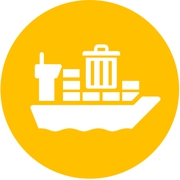 | |||
Sitka's Electricity Generation is Nearly Emission-free | Sitka is Only Accessible by Plane or Boat | Sitka Does Not Have Clear Boundaries for Some Emission Sources | Sitka Relies on Shipping for Goods and Waste Disposal | |||
| The Blue Lake and Green Lake Hydroelectric Projects provide Sitka with nearly 100% of its electricity. That is good for the total emissions from scope 2 (which is less than 1% from backup diesel generators) but emphasizes the need to carefully calculate scope 1 and 3 sources. Click here to learn more about Sitka's energy system today. In many community GHG emissions inventories, scope 2 is the largest contribution to their total emissions, depending on the available renewable energy resources. | As an islanded community, residents and visitors can only arrive by plane or boat. This makes the role of emissions from these sources more important to understand. As scope 3 sources, these emissions are difficult to calculate as they are often linked to information that is considered proprietary and not publicly available. Because of this, these numbers are calculated based on assumptions that can be used to estimate the amount of emissions these sources contribute. | Land-based emissions are much easier to calculate as the the sources have clear boundaries. However, as an islanded community, Sitka's "boundaries" are not necessarily limited to its land. Due to its reliance on water and air travel, the boundaries used to calculate the emissions from these sources do not necessarily end consistently. For example, in the case of air travel, should the a plane's emissions all the way from Seattle be counted or should only emission's in Sitka's airspace included? These are questions that the City's Sustainability Commission are helping PNNL answer. | Since all goods arrive in Sitka via barge, these emissions are important to include in the inventory. However, there is no standard way to calculate this number. Similarly, Sitka does not have a landfill that accepts most municipal solid waste. Many communities include waste disposal in their emission inventories because they have direct access to landfills. However, Sitka ships its waste south to Seattle, where it is then taken to the Roosevelt landfill in Southeastern Washington. More information about municipal solid waste and how recycling efforts impact emissions from this source will be available soon. | |||
 | Sitka's Greenhouse Gas Emissions InventoryAs part of the Sitka Community Renewable Energy Strategy, a community-wide greenhouse gas emissions inventory is being conducted for Sitka. The public comment period for the 2023 Sitka Greenhouse Gas Emissions Inventory Please submit comments to sustainability@cityofsitka.org | For questions or assistance, please email or call (907) 747-1856 |
 | Want to get alerts about the SCRES? Questions? Comments? Email sustainability@cityofsitka.org Phone (907) 747-1856 |
Information on this page was adapted from the Global Protocol for Community-scale Greenhouse Gas Inventories, 2021, World Resource Institute. Page last updated December 16, 2025 | |